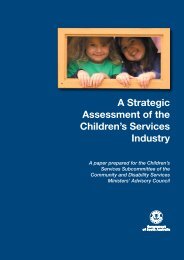Global Study On Child Poverty And Disparities (PDF) - Social Policy ...
Global Study On Child Poverty And Disparities (PDF) - Social Policy ...
Global Study On Child Poverty And Disparities (PDF) - Social Policy ...
Create successful ePaper yourself
Turn your PDF publications into a flip-book with our unique Google optimized e-Paper software.
Early marriage may be encouraged for daughters’<br />
protection, family honour and social obligation.<br />
There is evidence to suggest that girls who marry<br />
at young ages are more likely to marry older men<br />
and consequently are more likely to become<br />
widows at an early age. The MICS survey<br />
indicates that 32 per cent of currently married<br />
females age 15-19 were married to men 10 or<br />
more years older than them, while 10 per cent of<br />
women age 20-24 are currently married or in a<br />
union with a man who is 10 years older or more.<br />
Education<br />
Education in not compulsory in Vanuatu, and<br />
enrolments and attendance are among the<br />
lowest in the Pacific. The education system<br />
consists of early childhood centres for children<br />
age 3 to 5, primary education (years 1 to 6) for<br />
ages 6 to 12, junior secondary education (years<br />
7 to 10) for ages 13 to 16, senior secondary<br />
education (years 11 to 13/14) for age 17 to 20,<br />
and tertiary education for ages 13 to 18. The<br />
Ministry of Education is currently in the process<br />
of extending primary schooling to year 8, to cater<br />
for students to age 14 (ADB 2009a, pp. 93-95).<br />
The government has recently announced an<br />
initiative to abolish school fees. Instituting free<br />
education at the primary level is expected to<br />
deliver significant improvements in enrolment and<br />
education outcomes. 16<br />
As with health, the dispersed population presents<br />
a major challenge to service delivery and per<br />
unit costs in the education sector. In 2007, 25.8<br />
per cent of total government expenditure went<br />
to education, an increase of 4.5 per cent since<br />
2005. This represented 6.0 per cent of GDP<br />
in 2007, compared with 4.8 per cent in 2005<br />
(Ministry of Education 2007). While the level of<br />
funding is high, outcomes remain poor. Aside<br />
from geography, other significant constraints<br />
include a lack of qualified personnel and<br />
cultural constraints to school enrolment, such<br />
as expectations for children’s contribution to<br />
subsistence agriculture.<br />
National laws, policies and<br />
programmes<br />
In 2006, the Government of Vanuatu endorsed<br />
the Sector Wide Approach Planning Strategy to<br />
lead the development of the Vanuatu Education<br />
Sector Strategy 2007–2016. This strategy was<br />
16 The main source consulted for this section was the Ministry of Education’s Digest 2007,<br />
which summarizes key indicators and budget allocations for different levels of education<br />
across Vanuatu and within each region. Additional information on policy development,<br />
strategies and country plans are from outside sources, including the ADB Economic Report<br />
2009 and a review of NZAID funding commitments in Vanuatu.<br />
developed through a consultation process initiated<br />
by the National Education Summit of Education<br />
in 2006, and was approved by the Development<br />
Committee of Offices and the Council of Ministers.<br />
Its core goals include achieving universal primary<br />
education completion; strengthening literacy,<br />
language skills and numeracy; developing a<br />
national pre-school curriculum and training<br />
programme; improving curriculum at all levels;<br />
improving training of teachers and decreasing<br />
teacher-pupil ratios; improving facilities and<br />
resources; improving relationships with parents<br />
and improving management. The high-level<br />
PAA also establishes key strategic directions<br />
for education: improving access and ensuring<br />
a gender and rural/urban balance; raising the<br />
quality and relevance of education; improving<br />
planning and fiscal management, and developing<br />
a distinctive Vanuatu education system. In 2009,<br />
Planning Long, Acting Short further prioritised<br />
improving quality and phasing out primary school<br />
fees. As a result of these developments, a more<br />
focused plan is elaborated in the draft Vanuatu<br />
Education Road Map 2009. Its key targets are<br />
increasing net primary enrolments to 85 per cent<br />
by 2011 and 100 per cent by 2015 (an MDG<br />
goal); increasing literacy and numeracy skills;<br />
increasing the number of certified teachers;<br />
increasing technical and vocational enrolments<br />
and strengthening financial management in the<br />
sector.<br />
The key strategy is to ensure fee-free primary<br />
schools by 2012. This will be done through<br />
government grants to schools so that they<br />
can eliminate fees. In 2010 it was expected<br />
that parents will see a decline of fees by up to<br />
VUV5,000 per child, with grants to schools of<br />
about VUV6,800 per child. By 2012 it is expected<br />
there will be no need for compulsory parental<br />
contributions. The initiative is expected to cost<br />
about VUV500 million per year from 2012.<br />
Co-funded by NZAID and AusAID, the Vanuatu<br />
Education Support Action Plan was launched in<br />
June 2008, expected to build the capacity of the<br />
Ministry of Education to deliver a “higher quality<br />
of education to all children in Vanuatu.” The<br />
funds will also enable the Ministry to renovate 25<br />
primary schools and buy supplies for the students<br />
(NZAID 2008). The Plan also supports the Primary<br />
Education Improvement Project to improve<br />
teacher quality. AusAID, New Zealand, the<br />
European Union, France and the World Bank also<br />
contributed $2.5 million (to Vanuatu’s Education<br />
Sector Annual Plan 2007–2008 to improve basic<br />
education through curriculum reform, teacher<br />
training and purchasing of supplies.<br />
65
















